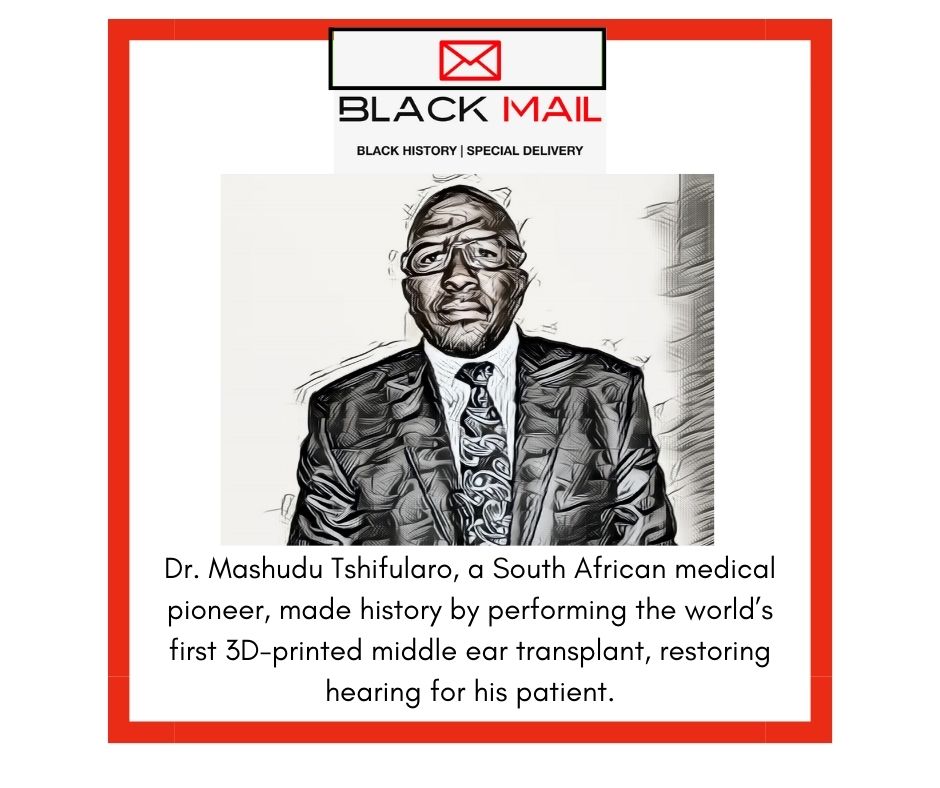Black History: Special Delivery!!

Dr. Mashudu Tshifularo (pronounced mah-SHOO-doo chih-foo-LAH-roh) is a South African medical pioneer and the first surgeon in the world to perform a middle ear transplant using 3D-printed bones successfully. His groundbreaking procedure has brought hope to millions suffering from hearing loss caused by damaged middle ear bones. Tshifularo’s work highlights the importance of innovation and access to medical technology in improving healthcare for underserved communities.
Mashudu Tshifularo was born on June 18, 1964, in Venda, a region in Limpopo, South Africa. Growing up in a rural area with limited access to healthcare, Tshifularo became passionate about medicine after witnessing the struggles his community faced in receiving proper medical care. Determined to make a difference, he pursued a career in healthcare, eventually graduating with a Bachelor of Medicine and Surgery (MBChB) from MEDUNSA (Medical University of Southern Africa).
During his training, Tshifularo showed a deep interest in ear, nose, and throat (ENT) medicine, an area with limited specialists in rural communities. He recognized that issues related to hearing and ear health were often overlooked and that patients in underprivileged areas had few options for advanced medical care. This realization motivated him to pursue groundbreaking solutions that could make specialized care more accessible.
Like many Black professionals in South Africa, Dr. Tshifularo has had to overcome systemic challenges tied to racism and inequality. The healthcare system in South Africa, shaped by the legacy of apartheid, historically limited opportunities for Black doctors and researchers. Access to funding, resources, and institutional support for innovation often favored white professionals and hospitals in wealthier areas, making it difficult for Black innovators to gain recognition or develop new solutions.
Despite these barriers, Tshifularo remained committed to improving healthcare for all. His perseverance and success as a surgeon, innovator, and academic leader helped break through these systemic inequalities. He also advocates for increased investment in African healthcare infrastructure, ensuring that communities historically marginalized by both race and poverty can benefit from cutting-edge medical technologies.
In March 2019, Dr. Tshifularo made global headlines by performing the world’s first middle ear transplant using 3D printing technology. The procedure involved creating customized 3D-printed titanium versions of the ossicles (the tiny bones in the middle ear) and successfully implanting them in a patient. The 35-year-old patient, who had lost his hearing due to a car accident, experienced hearing restoration after the surgery, confirming the procedure’s success.
This innovation addressed conductive hearing loss, a condition caused by damage to the middle ear bones, which transmit sound vibrations to the inner ear. Common causes of this type of hearing loss include trauma, infections, and congenital defects. The procedure demonstrated that 3D printing technology could be used to precisely reconstruct these bones, offering a cost-effective solution for patients around the world.
Tshifularo emphasized that the procedure was not limited to one type of patient. “This surgery can be done on anyone—including newborns—whose hearing loss is caused by middle ear problems,” he stated in interviews. His goal was to make this technology widely available to communities that typically lack access to advanced surgical interventions.
In addition to his groundbreaking medical work, Dr. Tshifularo is a professor of Otorhinolaryngology (head and neck surgery) at the University of Pretoria. He is deeply committed to educating the next generation of doctors and researchers, particularly those who come from disadvantaged backgrounds. Through mentorship programs, he encourages young medical professionals to think creatively and embrace technological innovations to solve healthcare challenges.
Dr. Tshifularo has also been vocal about the need to improve healthcare infrastructure in Africa. He believes that integrating cutting-edge technology, like 3D printing, into routine medical practice can reduce disparities in healthcare access and outcomes. His work serves as a model for how local innovation can have a global impact.
One of the biggest challenges Tshifularo has faced in implementing new technologies is the lack of funding and resources in the healthcare sector. Advanced surgical techniques, like 3D-printed implants, require significant investment, but many hospitals, particularly in rural areas, struggle with limited budgets and outdated equipment.
To address this, Tshifularo advocates for increased government and private sector investment in healthcare innovation. He has called for policies that support both research and infrastructure development, ensuring that advanced technologies become accessible to underserved communities. His advocacy is rooted in his belief that healthcare is a human right and that medical advancements should benefit all people, not just those in wealthier regions.
Dr. Mashudu Tshifularo’s contributions to medicine have made him an icon of innovation and resilience. His pioneering work in 3D-printed ear transplants exemplifies the importance of leadership and representation in global healthcare. He has received numerous accolades for his achievements and continues to inspire medical innovation across Africa and beyond. His vision for equitable healthcare, driven by technology and education, has positioned him as a leader not only in medicine but also in the movement to reduce healthcare inequality.
His success story also serves as an important reminder of the potential within African healthcare systems to produce world-leading innovations. By integrating mentorship, education, and cutting-edge research, Dr. Tshifularo has set a powerful example for future generations of healthcare leaders.
Another installment of melanated mail has been delivered. Ponder, reflect, and pass it on.
Sources:

